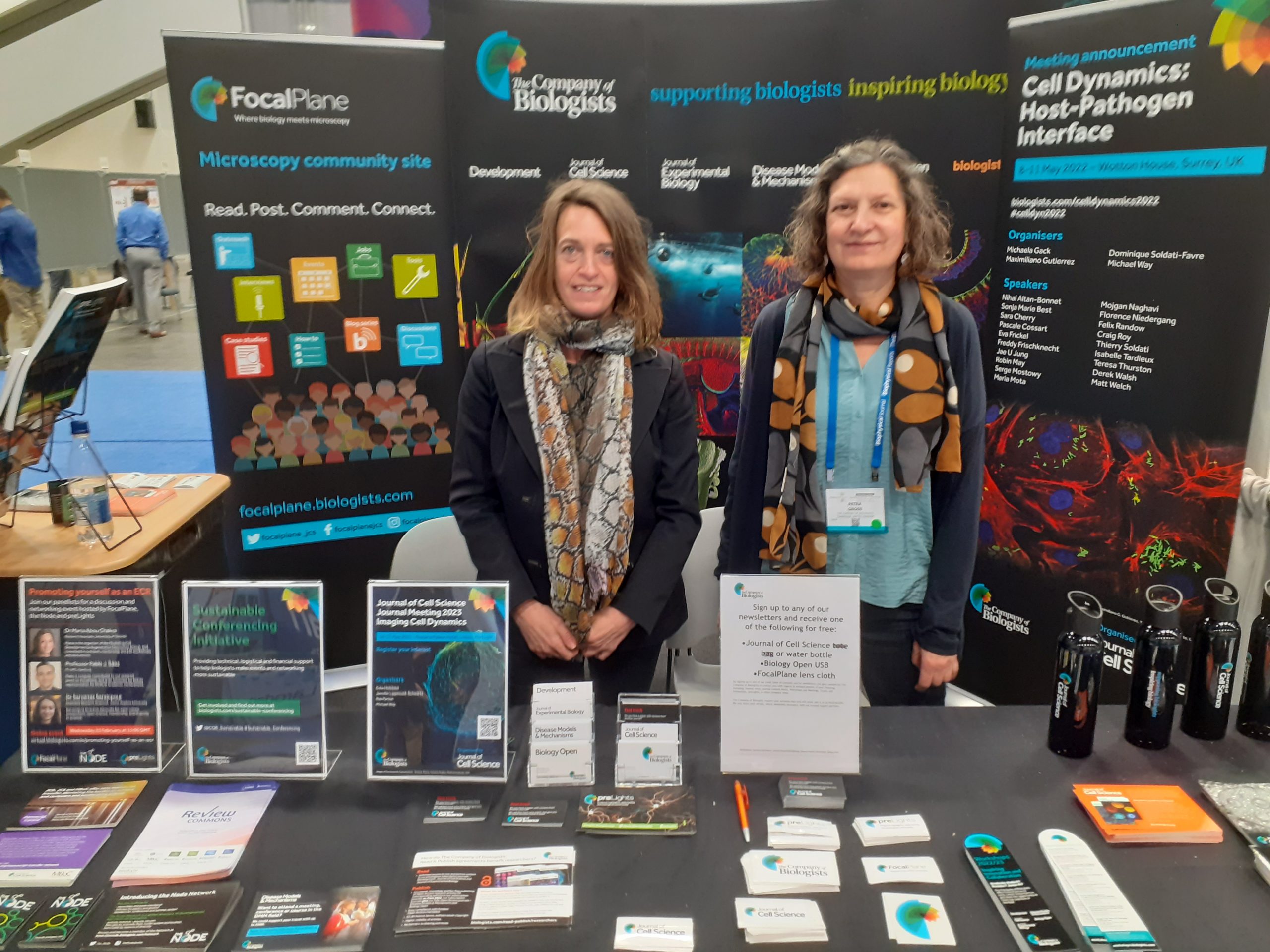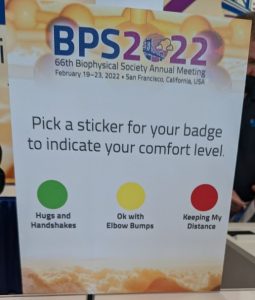
9 March 2022
The 2022 Biophysical Society (BPS) meeting took place from 19-23 February and was the first in-person exhibition any of our journal teams have attended since the pandemic began. Familiar routines began to come back to us as we shipped our trusty booth to San Francisco and planned for flights. New procedures also became evident, such as the antigen tests required for international travel.
The BPS annual meeting normally sees the convergence of around 6,000-7,000 members from an interdisciplinary community working across the life, physical, and computational sciences. Due to the pandemic, attendance was somewhat reduced, but at our booth we still welcomed a large number of researchers. We enjoyed speaking with so many researchers who can benefit from our Read & Publish agreements, and who were delighted to discover that their institutes were participating in the scheme. We also found that our Travelling Fellowships were as popular as ever, with many students keen to take the opportunity to embark on collaborative lab visits now that travel restrictions are easing. “It was great to meet researchers who were clearly excited to be back at a meeting, or for some at their very first one!” our Marketing Associate, Claire Gascoigne, said. “And always lovely to see familiar faces who visit the booth every year”.
The return to in-person conferences has been particularly important for early-career researchers. Many have only been able to experience virtual meetings up until this point. Soni Mohapatra is a postdoctoral researcher in the Ha Lab at Johns Hopkins University, where her research centres on engineering proteins with light-tuneable functions. She is also a member of our preLights community, highlighting the latest preprints in areas such as synthetic biology and bioengineering. Her last in-person meeting was, coincidentally, the 2019 BPS meeting in Baltimore. “It was fascinating to see how wonderfully the science in different fields has progressed in the last two years of the pandemic,” Soni said. “I used the opportunity of this in-person meeting to connect with old friends and make some new ones. It was great to meet some of my collaborators whom I had only seen on the computer screen in the last two years”. Soni was particularly invigorated by the poster session; she presented two posters and left the meeting feeling motivated by the discussions she’d had with a broad audience of fellow researchers.

The meeting endeavoured to help attendees feel comfortable, since many, like Soni, were attending an in-person conference for the first time since the start of the pandemic. “I had apprehensions about being in close proximity with such a large number of people in enclosed spaces,” Soni explained, “but the meeting required proof of booster vaccination and everyone was masked, which alleviated some of the fears”. Attendees were also able to use stickers to indicate their comfort levels regarding social distancing.
The scientific programme was, predictably, disrupted by the current pandemic. Some speakers were unable to give their presentation due to contracting the virus or ongoing travel restrictions in their home countries. Given that schedules seem particularly liable to change in the present climate, Petra Gross, Senior Editor of Journal of Cell Science, advised that “people should be prepared to be flexible when attending conferences under the current circumstances”. Despite this, energies were high; attendees seemed keen to ask questions and engage with speakers, resulting in lively discussions, something which was challenging at virtual conferences.
Alongside the science, the conference also featured a career development centre which offered the opportunity for attendees to have their CVs reviewed, and to post or browse job listings. Networking breakfasts for early-career researchers and panel discussions on career options provided plenty of food for thought, and new BPS members were made to feel welcome at a specific session. This year, there was also the first Justice for Underrepresented Scholars Training in Biophysics (JUST-B) poster session, designed to celebrate the wonderful science being conducted by underrepresented scientists at different career levels, and this was well received.
Towards the end of the meeting, thoughts inevitably turned to the future of conferences in a post-pandemic world. “It is clear that in-person meetings in cities such as San Francisco can be run successfully with maximum safety,” said Dr Dennis Discher, Director of the National Cancer Institute’s Physical Sciences in Oncology Centre, and member of the JCS Editorial Advisory Board. “Other cities in the US are clearly problematic. The extra safety no doubt helped draw senior-level biophysicists as well as more junior colleagues to make the needed, healthy mix of seasoned and new perspectives at this year’s meeting. The ‘no hybrid’, vaccine and mask requirements also likely helped maximise the diversity of biophysicists from Europe, Australia, Singapore, Canada, and all over the US”. Dr Discher also highlighted the importance of future meetings for early-career researchers as we move beyond the worst years of the pandemic: “The last two years have been especially tough on trainee networking, but the many full sessions at the meeting and the healthy Q&A after each talk or at each poster have always been foundational to progress in this important field. They undoubtedly helped in years past to drive new science as well as new technologies – including the lipid nanoparticles that make up some of the key vaccines”.
Whatever the future holds for researchers in terms of conference formats, it is clear that this year’s BPS meeting has instilled a sense of optimism amongst its attendees. “For me, the meeting was a reminder of the sense of togetherness and belonging we scientists share as a community,” Soni said. “Despite the hardships we encountered in the past years, we toiled hard in labs and the conference served as a reminder of how science has progressed. Hopefully, I can attend this meeting next year without a mask and exchange smiles with fellow scientists”.
Check out Soni’s preList of preprints presented at the 2022 BPS meeting.
Under the current circumstances we are planning to attend the following exhibitions this year. We hope all plans can go ahead and look forward to seeing you at our booth:
- BSCB-BSDB Joint Annual Spring Meeting, 3-6 April 2022 in Warwick, UK
- ISSCR Annual Meeting, 15-18 June 2022 in San Francisco, USA
- SEB Annual Conference, 5-8 July 2022 in Montpellier, France
- Joint SDB-PASEDB Meeting, 16-20 July 2022 in Vancouver, Canada
- Cell la vie 2, 21-23 September 2022 in Paris, France
- ISDB Meeting, 16-20 October 2022 in Algarve, Portugal
- ASHG Annual Meeting, 25-29 October 2022 in Los Angeles, USA
- ASCB-EMBO Meeting, 3-7 December 2022 in Washington DC, USA








You must be logged in to post a comment.